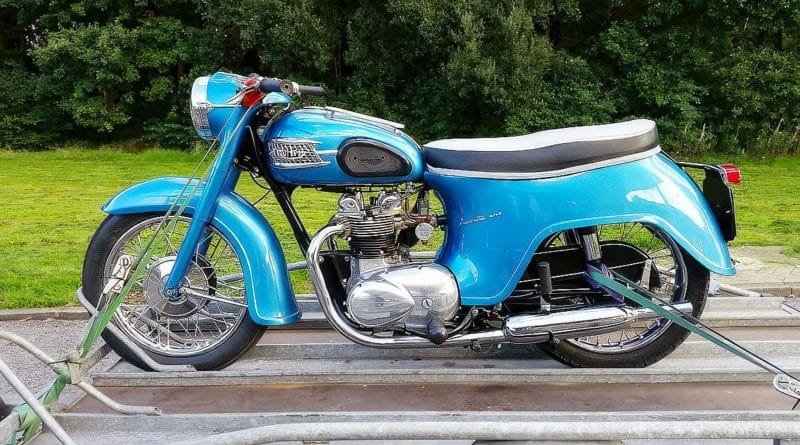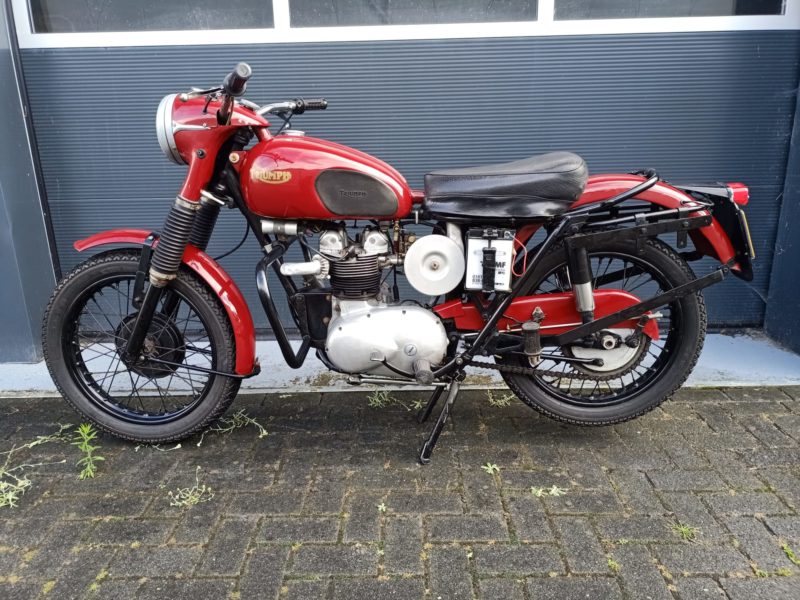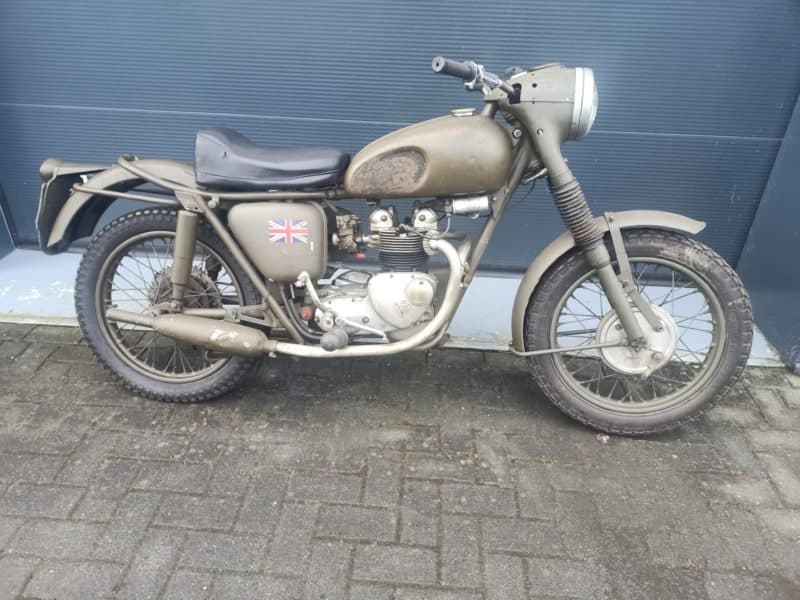De Triumph 3TA started life in 1957 in the once famous, later infamous Meriden. It was Triumphs first motorcycle with a 'modern' unit construction engine where crankshaft and gearbox lived comfortably in the same house. The newborn was nicknamed 'Twenty One'. That stood for the Jubilee year of the Triumph Engineering Company and for 'twenty one cubic inches displacement', the American 'translation' of 350 cc displacement. And in 1957, 350 cc was a serious medium-duty engine.
Increasingly bald
The first Triumph 3TA models had a sheet steel shell for the then fashionable looks. They were soon affectionately/disparagingly referred to as 'bathtub'. The market did not respond very enthusiastically to it. Many copies were stripped. The sheet metal went on the belt and that is why complete bathtubs are now rare and sought after. Gradually the sheet metal disappeared so that the 3TA became more and more bare. The nacelle was retained until the end of 1966. Oh yes: the TAs date from the time when Triumph had to cut back on everything. This also applied to the bicycle parts. Citizen 3TAs steered less well. But the slower ridden army bikes did their job well.
Army versions
When the Dutch army bought more than 1966 1000TAs in 3, it was an order worth millions. For the Dutch army they were modified a bit with a Solex carburetor, a special vent, a half buddy, a 2-in-1 exhaust system, and serious side bags and a different rear light. Furthermore, green paint was used everywhere, no chrome. They also had an older model front brake, by the way. In fact, such a greenfinch was an ordinary one Triumph 3TA with slightly modified oversampling ratios for off-road use.
Issues
You would think that Triumph would carry out such an order lovingly and carefully. But Triumph was struggling with a capacity problem during that period. Half-finished engines were simply put outside until further notice due to lack of space. That also happened with the Triumph 3TA. They were placed on the lawn in front of the factory with a piece of tarpaulin over it. Due to the humid climate and the fast-growing grass, they suffered from serious rust before they had even walked a step on their own.
Back at the factory, a lot had to be repaired again. But that did not prevent rainwater from sloshing into the frames of freshly delivered engines. Despite the theoretically perfect maintenance in the army, according to fixed protocols, the 3TAs remained maintenance-sensitive. And in the army they were treated completely unlovingly. This also applied to the blocks completely trimmed by Harry Meijer. Often they were already broken before they were installed.
In 1988, the 3TAs were for sale to farmers, citizens and outdoor enthusiasts. But especially for the traders. Whole rows of 3 TAs were on display in Soesterberg. That was an uninspiring, sad sight, because the engines were in all kinds of weather. Now you can say that they were used to that in their youth, but still…
Many ex-Army 3 TAs have been killed over time. You run that risk in the army. But there are still quite a few within the TOCN. And 'in the wild' they are still offered. Because such an army green ex-civil servant does not have the wildly brutal status of a Bonneville, such a veteran is now simply pleasantly affordable. In addition, we are now in the phase where 'civilized' ex-service bicycles are even less sought after than the ones in combat gear. Lucky are these Triumphs easy to restore. Although: http://tdvma.blogspot.com/2011/01/triumph-3ta-defensie-restauratie.html makes you think…
But you run into one Triumph 3TA restoration not empty on expensive chrome. In addition, a 3TA now fits well in traffic if you stay far from the highway.
The Moto Guzzi's they succeeded have meanwhile also left and come among the citizens.
Time flies when you're having fun.
Let's find out what our army is riding on now...
More stories about classic engines can be found via this link.









Hi,
It is still incomprehensible that the 3TA was chosen at the time, while Puch was also used in the tests
mee deed. There will be the necessary bottles of wine and boxes of cigars
.
Admittedly refused the service at the time (I've been in an archive for 18 months), but
there is a 3TA in the collection. It actually drives quite nice, for a four-stroke.
HansP
Advantages of a tender? Something like Pon/VW did for the police and army?
But do I also see a small Velo Boxer in the photo?
At defense they ride on KTM, I've already posted 2 x with a link, but it doesn't get through the moderator. So don't ask.
Hello Henk, comments containing links must be approved separately by the editors. That's why they're only on it now.
Oh ok, on a bike like that!
Thank you for the explanation.
Internet is your friend:
https://www.defensie.nl/onderwerpen/materieel/voertuigen/ktm-motorfiets
So KTM.
Great that one Triumph bathtub, those other versions too by the way. Nice brand.
I enjoyed riding it during my service with 43 Tank Battalion in 1971. Occasionally a throttle cable broke and lighting headlight regularly replaced. Unfortunately I am not technical enough to remember such a bike and would like to ride one more.
MvgM the Black light 70-5
If you buy a good copy now, you will drive more carefree / problem-free than during your service. Then you can even drive comfortably without technical skills. And if there is anything, your mobile phone is your tool and the roadside assistance is your best friend
Yes, it is still there and no one wants it!! incomprehensible anyway
Sweet little things, though Triumphs. 'The bathtub'
I'm going to break 🤣. That maintenance sensitive seems to be an English thing. I'm not sure but at the time that Triumph built an 'everything in a box' block, Harley still lived separately from bed and board and people you visited were not happy if you, for example, put a WLAII with total loss lubrication on the chains there on the tiled path parked at the front door. The Harley invariably left its signature
Apples and pears…; the WLA is a design from 1937 (actually 1929), the 3TA is from '57..
At that time, HD also had a block engine for the K/XL models.
And a non-leaking Brit is often a sign of having to top up with oil.
But you write it well; Harleys leak because they have a chain dropper.
I've had a tub with a sawn back piece so it looked like a 500 that didn't have a tub. It was the umpteenth hand, as a poor student I couldn't afford more. Always started, little compression, but had a lot of fun with it. Twice on holiday to France and also toured through the Netherlands with a girlfriend on the back. Sold and bought an R50 with Earless fork, it went better and more comfortable with duo riding!
Now, almost 75 years, still riding, BMW R1200R.
Nice Hans, nice that you are still actively driving!
During my time in service, the orderlies already drove a V50, but there was still 1 rusty TA in the shed…probably once stuffed in the corner and simply forgotten.
I tinkered with it on a blue Monday morning in the hope of driving it around the barracks, but had to continue with the broken LaRo that was soon replaced by MB G(elande) class..
I wonder if the Triumph still in hard condition..
Hi Pascal, I spent 14 months in the Harde, class 80-5. 107 Afdva. To be honest, I don't remember which engines were in use at the time, but I think the Guzzis came a little later.
In 78 I started in Assen (42 recovery) as a motorcycle mechanic, 3rd echelons work. Motorcycles that were no longer good were then removed via the domains. Indeed, they always leaked oil, the oil pump broke down regularly, replaced many of them and had them in stock, when I retired in 1982, there was still plenty of work on the Triumph driven, if you had a good copy, he drove 120 km per hour, others sometimes did not exceed 80 km per hour.
Two photos of the open day in the Martinihal in Groningen.